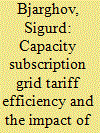| Srl | Item |
| 1 |
ID:
185701


|
|
|
|
|
| Summary/Abstract |
While volume-based grid tariffs have been the norm for residential consumers, capacity-based tariffs will become more relevant with the increasing electrification of society. A further development is capacity subscription, where consumers are financially penalised for exceeding their subscribed capacity, or alternatively their demand is limited to the subscribed level. The penalty or limitation can either be static (always active) or dynamic, meaning that it is only activated when there are active grid constraints. We investigate the cost impact for static and dynamic capacity subscription tariffs, for 84 consumers based on six years of historical load data. We use several approaches for finding the optimal subscription level ex ante. The results show that annual costs remain both stable and similar for most consumers, with a few exceptions for those that have high peak demand. In the case of a physical limitation, it is important to use a stochastic approach for the optimal subscription level to avoid excessive demand limitations. Facing increased peak loads due to electrification, regulators should consider a move to capacity-based tariffs in order to reduce cross-subsidisation between consumers and increase cost reflectivity without impacting the DSO cost recovery.
|
|
|
|
|
|
|
|
|
|
|
|
|
|
|
|
| 2 |
ID:
175897


|
|
|
|
|
| Summary/Abstract |
The growing capacity of intermittent energy sources causes more frequent system imbalances as well as congestion. Demand flexibility is a valuable resource that can be used to resolve these. Unfortunately, flexibility can also contribute to congestion, particularly when used to balance the grid. Using flexibility to solve grid problems without creating new ones requires well-designed financial incentives. Congestion management mechanisms (CMMs) are a primary example of such incentives. The question is which of these is most effective in preventing congestion with minimal impact on trading on the imbalance market. This question is answered by comparing traditional CMMs such as grid tariffs to a local flexibility market on their impact on the load in the grid and the lost value of flexibility on the imbalance market. This analysis shows that energy tariffs are not suited for preventing congestion. Capacity tariffs are able to prevent congestion but they impose limitations on the consumer which significantly reduce the value of flexibility on the imbalance market. The flexibility market, an example of a local market, is effective if aggregators do not have a position day ahead or if the distribution system operator limits the buying of flexibility a day before delivery.
|
|
|
|
|
|
|
|
|
|
|
|
|
|
|
|